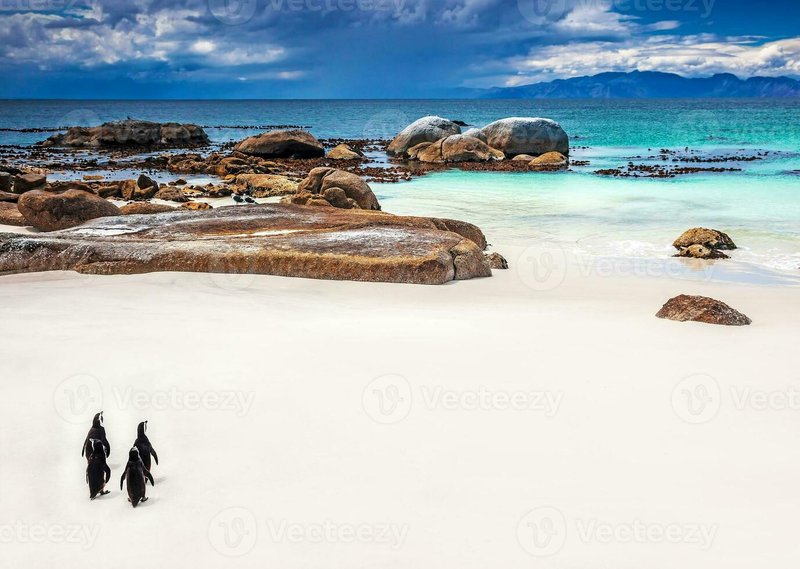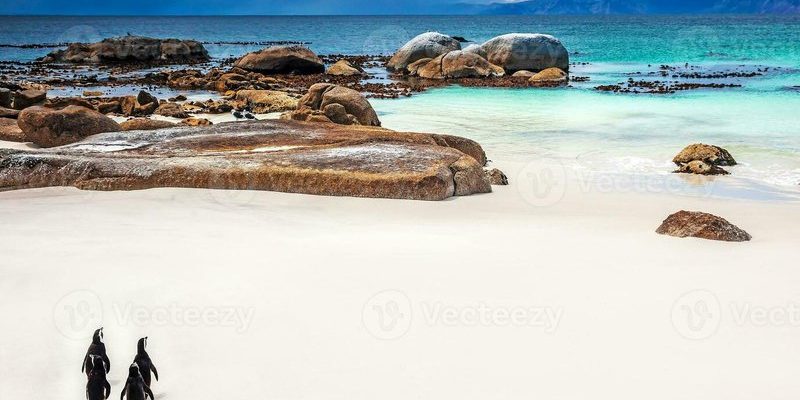
The African Penguin is one of the most charming and unique species of penguins found in the world. With their distinct black-and-white coloring and playful nature, these flightless birds quickly capture the hearts of anyone fortunate enough to observe them. Sometimes affectionately called “jackass penguins” due to their braying donkey-like call, African penguins are a captivating sight along the southwestern coast of Africa. But there’s much more to learn about these delightful creatures than just their quirky names.
Imagine standing on a sun-kissed beach, the sound of crashing waves blending with the playful squawks of these little penguins. As they waddle along the shoreline and dive gracefully into the surf, you can’t help but feel a sense of wonder at their resilience and adaptability in a changing world. However, with their populations dwindling, it’s crucial to understand their habits, habitats, and the challenges they face. So, let’s dive deeper and uncover the fascinating life of the African penguin!
Physical Characteristics
African penguins have a unique appearance that sets them apart from other species. They typically stand about 24 to 28 inches tall and weigh between 2.2 and 11 kilograms. Their striking black upper body contrasts beautifully with a white belly, adorned with a distinctive pattern of black spots. These spots are unique to each penguin, much like fingerprints for humans.
Their wings are adapted into flippers, allowing them to swim efficiently in the water. African penguins have a streamlined body that helps them maneuver through the currents, reaching speeds of up to 20 miles per hour underwater. Their webbed feet also aid in swimming and provide stability when they’re on land.
Interestingly, African penguins have a layer of insulation in the form of blubber and dense feathers that keep them warm in cold waters. Their feathers, unlike other birds, are tightly packed and waterproof, providing additional protection. When you spot one of these adorable birds on the beach, you’ll often see them preening their feathers, which is not just for show—it’s essential for maintaining their waterproof coat.
Habitat and Distribution
The African Penguin calls the rocky shores and islands of southern Africa home. Their primary breeding colonies are found on islands like Dassen Island, Robben Island, and the Penguin Island Nature Reserve. These areas provide ideal conditions for nesting and foraging, with sandy beaches and ample access to food.
Often seen basking in the sun or swimming in the ocean, African penguins prefer coastal waters that range from 10 to 20 degrees Celsius. Their diet mainly consists of small fish such as sardines and anchovies, which they catch while diving up to 130 meters deep. Although they are excellent swimmers, their habitats are threatened by climate change, overfishing, and oil spills, which can severely impact their food supply and nesting sites.
Interestingly, the African penguin is known to travel significant distances in search of food. Foraging trips can take them up to 80 kilometers from their nesting sites. This adaptability highlights their resilience, but it also underscores the challenges they face in a rapidly changing environment.
Breeding and Reproduction
The breeding season for African penguins typically spans from March to May in their native habitats. They are monogamous and often return to the same partner year after year. When the female is ready to lay eggs, she will build a nest in a burrow or under bushes for protection from the elements and predators.
After laying two eggs, both parents share the responsibility of incubating them for about 40 days. It’s a teamwork effort that showcases the bond between the pair. Once the eggs hatch, the chicks are covered in downy feathers and are initially dependent on their parents for food and warmth.
As they grow, the chicks start to venture out and explore their surroundings. Parent penguins regurgitate food for their young, which is essential for their growth. The fledglings usually leave the nest at around 60 days old, but they often remain close to their parents, learning the ways of the ocean until they are fully independent.
Diet and Feeding Habits
The diet of the African penguin primarily consists of small fish, with sardines and anchovies being the favorites. They are opportunistic feeders, meaning they’ll adjust their diet based on what’s available. During foraging, they can dive up to 130 meters and hold their breath for about two minutes while searching for their next meal.
These penguins use a hunting technique called “porpoising” where they leap out of the water while swimming. This allows them to conserve energy and remain stealthy when approaching schools of fish. They possess excellent eyesight, enabling them to spot their prey even in murky waters. However, their feeding habits are heavily influenced by the availability of fish, which has become a growing concern due to overfishing in their habitats.
During feeding season, adult African penguins can consume about 1 kilogram of fish per day. This need for sustenance underscores the importance of protecting their natural food sources. As fish populations dwindle, these endearing birds face nutritional challenges that threaten their survival.
Conservation Status
Unfortunately, African penguins are classified as Endangered by the International Union for Conservation of Nature (IUCN). Their populations have significantly declined over the past several decades due to various factors, including habitat loss, overfishing, and climate change. Once abundant in their natural range, there are now only about 50,000 breeding pairs left in the wild, making their future precarious.
Conservation efforts are underway to protect their habitats and promote awareness about the challenges they face. Organizations are working to restore breeding colonies, monitor fish stocks, and reduce human impact on their nesting areas. Ecotourism also plays a role in raising awareness and funding for conservation initiatives, allowing people to witness these remarkable birds while supporting their survival.
Community involvement and international cooperation are key to ensuring the future of the African penguin. By educating others about their plight, we can inspire action to protect this beloved species and its habitat for generations to come.
Table of Interesting Facts
| Scientific Name: | Spheniscus demersus |
| Average Height: | 24-28 inches |
| Weight: | 2.2-11 kg |
| Average Lifespan: | 10-15 years in the wild |
| Primary Diet: | Sardines, anchovies |
| Breeding Season: | March to May |
Behavior and Social Structure
African penguins are known for their social nature, often seen in large, noisy colonies. These colonies provide safety in numbers and are vital for their breeding success. Within the colony, penguins establish strong social bonds and communicate through a variety of vocalizations and body language. Their unique calls help them identify each other, even in crowded groups.
Within these colonies, you’ll often find penguins engaging in playful behavior, such as sliding down sandy slopes or swimming in synchrony. They are also known for their preening rituals, where they clean and waterproof their feathers. This grooming behavior is essential for maintaining their insulation and buoyancy while swimming.
Interestingly, African penguins exhibit signs of affection toward one another. They often engage in mutual preening, which strengthens their bond. You might even catch them “holding hands” as they stand together, creating a heartwarming image that highlights their intimate relationships.
Threats and Challenges
Despite their resilience, African penguins face numerous threats that jeopardize their survival. One of the primary challenges is habitat loss due to human encroachment and climate change. As coastal development increases, nesting sites become limited, and access to food sources declines.
Overfishing is another significant concern. With many fish stocks being depleted, African penguins struggle to find adequate nourishment. This reliance on a dwindling food source makes them especially vulnerable, as even small changes in the ecosystem can have a drastic impact on their populations.
Additionally, oil pollution poses a severe risk to these birds. Oil spills can coat their feathers, impairing their ability to insulate and swim effectively. Conservationists emphasize the importance of reducing oil spills and protecting marine environments, ensuring that African penguins have a fighting chance against these challenges.
How to Help African Penguins
As individuals, there are several ways we can contribute to the conservation of African penguins. Supporting wildlife conservation organizations dedicated to protecting these birds is an excellent place to start. Many organizations focus on habitat restoration, research, and education, giving you an opportunity to make a difference.
Educating yourself and others about the challenges facing African penguins can raise awareness and inspire action. Consider participating in coastal clean-up events to help preserve their habitats and protect marine life. By taking part in these activities, you not only support penguin conservation efforts but also foster a love for nature in your community.
Moreover, if you’re traveling to areas where African penguins are found, choose responsible ecotourism options. Visiting rehabilitation centers and wildlife reserves allows you to learn more about these remarkable creatures while ensuring that your tourism dollars support conservation efforts. This way, you play a part in their ongoing story.
FAQ
What do African penguins look like?
African penguins have a distinctive black-and-white appearance. Their upper bodies are black, and they have white bellies. Each penguin has a unique pattern of black spots, making them easily identifiable. They stand about 24 to 28 inches tall and weigh between 2.2 to 11 kilograms.
Where do African penguins live?
African penguins are primarily found along the southwestern coast of Africa. They inhabit rocky shores, islands, and sandy beaches, with major breeding colonies located on islands like Dassen Island and Robben Island.
How fast can African penguins swim?
African penguins are agile swimmers and can reach speeds of up to 20 miles per hour in the water. Their streamlined bodies and flipper-like wings make them well-adapted for swift swimming as they hunt for fish.
How do African penguins communicate?
These penguins communicate through a series of vocalizations, which can include braying calls that sound like a donkey. They also use body language, such as bowing and preening, to convey messages within their social groups.
What is the lifespan of an African penguin?
In the wild, African penguins typically live between 10 to 15 years. However, their lifespan can be longer in captivity, where they receive constant care and protection from threats in their natural environment.
Are African penguins endangered?
Yes, African penguins are classified as ‘Endangered’ by the IUCN due to declining populations. Their numbers have drastically decreased due to habitat loss, overfishing, and climate change, prompting conservation efforts to protect them.
What do African penguins eat?
The primary diet of African penguins includes small fish like sardines and anchovies. They often hunt in groups and can dive as deep as 130 meters to chase their prey.
How can I help African penguins?
You can help African penguins by supporting wildlife conservation organizations, participating in coastal clean-ups, and choosing responsible ecotourism options when visiting their habitats. Educating yourself and raising awareness about their plight is also a key step in supporting their conservation.
Do African penguins mate for life?
Yes, African penguins are generally monogamous and form long-term bonds with their partners. They often return to the same mate each breeding season, which showcases their strong social connectivity.
What threats do African penguins face?
African penguins face several threats, including habitat loss due to coastal development, overfishing that reduces their food supply, and oil spills that can harm their health and survival. Conservation efforts are essential to address these challenges.
Can African penguins fly?
No, African penguins cannot fly. Like all penguins, they are flightless birds adapted to life in the water. Their wings have evolved into flippers, which help them swim efficiently but make flight impossible.
What is the role of conservation organizations for African penguins?
Conservation organizations play a crucial role in protecting African penguins by working to preserve their habitats, monitor populations, and educate the public about their plight. They also engage in research and rehabilitation efforts to ensure the species’ survival.

